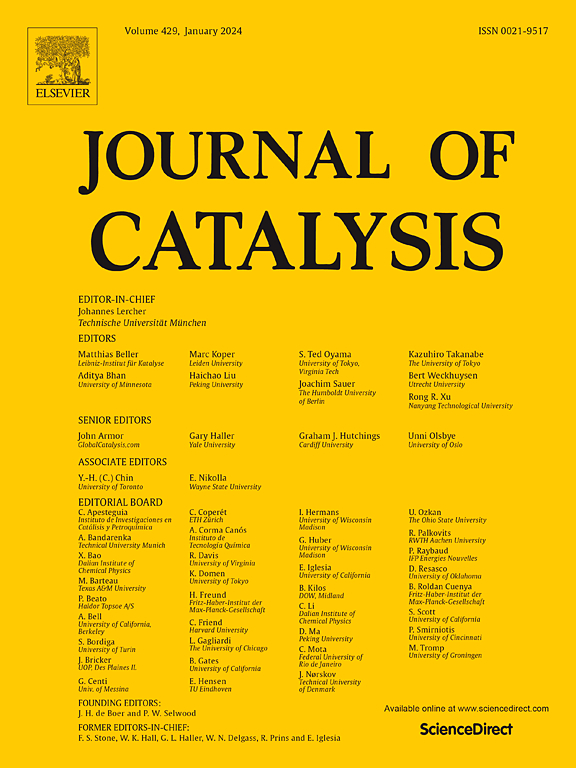Mo2C晶界协同活性位点上尿素的电化学合成
IF 6.5
1区 化学
Q2 CHEMISTRY, PHYSICAL
引用次数: 0
摘要
在催化剂表面设计多种具有协同功能的活性位点对尿素合成具有很大的前景,但形成这些特定位点并确保其功能仍然是一个突出的挑战。在此,我们提出了两种具有内在协同活性位点的Mo2C晶界(GBs),促进了C和N种的耦合,实现了高效的尿素合成。通过密度泛函理论(DFT)计算,我们验证了GBs上带正电的Mo原子对CO2表现出较高的吸附和还原活性,而相邻的Mo原子有助于N2或NO的活化。这些活性位点的协同作用使C-N偶联在具有超低极限电位(−0.24 ~ −0.42 V)的gb上自发进行。通过对析氢反应和氮还原反应的对比分析,证实了在Mo2C GBs上生成尿素具有较高的选择性。我们的工作表明,通过多个活性位点之间的协同合作,GB工程是一种很有前途的尿素生成策略,从而为合理设计有效的尿素电合成催化剂铺平了道路。本文章由计算机程序翻译,如有差异,请以英文原文为准。


Electrochemical synthesis of urea at cooperative active sites on Mo2C grain boundary
The design of multiple types of active sites with cooperative functions on catalyst surface holds great promise for urea synthesis, yet forming these specific sites and ensuring their functionality remain a prominent challenge. Here, we propose two types of Mo2C grain boundaries (GBs) that feature intrinsic cooperative active sites, facilitating the coupling of C and N species and achieving efficient urea synthesis. By density-functional theory (DFT) calculations, we verify that positively charged Mo atoms on the GBs exhibit high adsorption and reduction activity for CO2, whereas adjacent Mo atoms contribute to the activation of N2 or NO. The cooperative effects of these active sites enables C-N coupling to proceed spontaneously on the GBs with ultralow limiting potentials (−0.24 ∼ −0.42 V). Furthermore, analysis of the competing hydrogen evolution reaction and nitrogen reduction reaction confirms the high selectivity to generate urea on Mo2C GBs. Our work demonstrates GB engineering as a promising strategy for urea generation through the synergistic cooperation between multiple active sites, thus paving the way towards the rational design of effective catalysts for urea electrosynthesis.
求助全文
通过发布文献求助,成功后即可免费获取论文全文。
去求助
来源期刊

Journal of Catalysis
工程技术-工程:化工
CiteScore
12.30
自引率
5.50%
发文量
447
审稿时长
31 days
期刊介绍:
The Journal of Catalysis publishes scholarly articles on both heterogeneous and homogeneous catalysis, covering a wide range of chemical transformations. These include various types of catalysis, such as those mediated by photons, plasmons, and electrons. The focus of the studies is to understand the relationship between catalytic function and the underlying chemical properties of surfaces and metal complexes.
The articles in the journal offer innovative concepts and explore the synthesis and kinetics of inorganic solids and homogeneous complexes. Furthermore, they discuss spectroscopic techniques for characterizing catalysts, investigate the interaction of probes and reacting species with catalysts, and employ theoretical methods.
The research presented in the journal should have direct relevance to the field of catalytic processes, addressing either fundamental aspects or applications of catalysis.
 求助内容:
求助内容: 应助结果提醒方式:
应助结果提醒方式:


